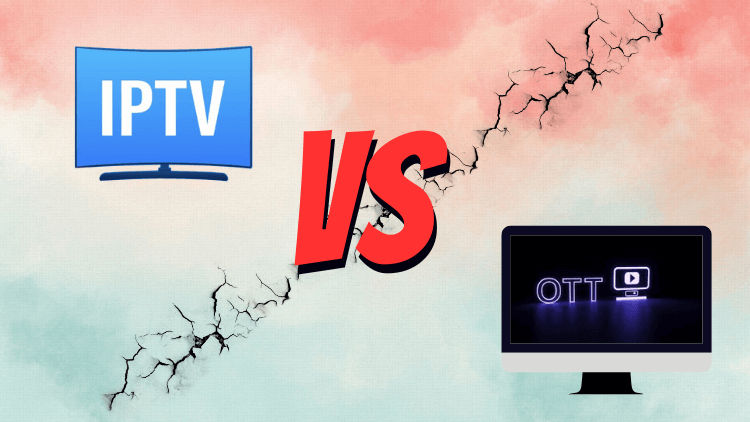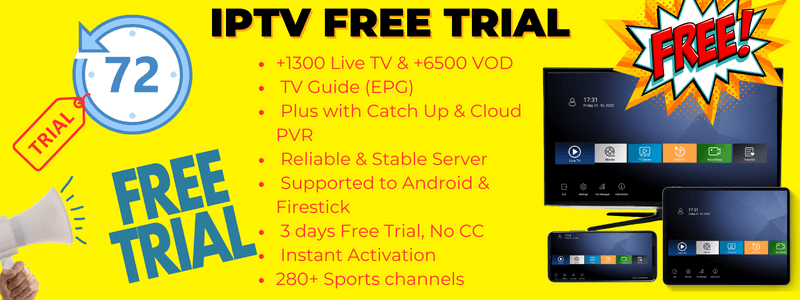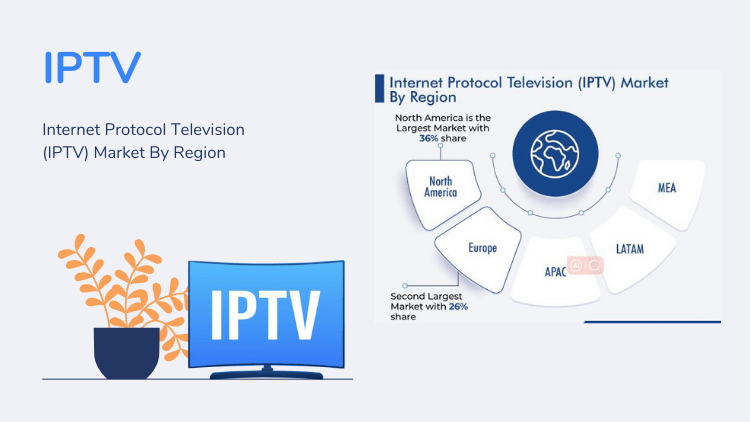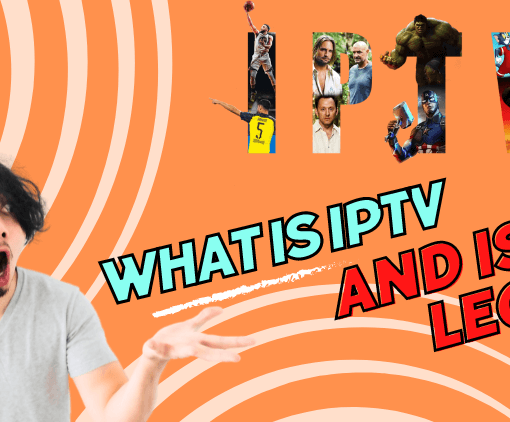In the dynamic realm of digital entertainment, the battle between IPTV and OTT is shaping the future of streaming technologies. IPTV, short for Internet Protocol Television, and OTT, or Over-The-Top, both offer distinct advantages and unique viewing experiences. Let’s embark on a comparative journey to dissect these two streaming giants.



Table of Contents
What is IPTV Mean?
IPTV, short for “Internet Protocol Television,” represents a technological shift in television content delivery. Unlike conventional cable or satellite methods, IPTV leverages Internet Protocol (IP) networks to bring TV channels and on-demand content to audiences.



The standout feature of Premium IPTV is its support for multicast, facilitating multi-user, multi-room, and multi-device viewing without compromising bandwidth usage. This aspect is particularly advantageous for users with limited Internet speeds, positioning IPTV as a primary substitute for traditional cable TV. Let’s delve into how this technology operates.
Read IPTV: Why is it the TV of the future and Exploring IPTV: What is IPTV and Is it Legal.
How Does IPTV Work?
IPTV revolutionizes the way videos and TV shows are delivered by storing them on remote servers and segmenting them when requested by the end user. This efficient process employs a one-to-many distribution technique, delivering content to all requesting IP addresses across the network without overburdening the user’s internet connection. The intricate mechanism unfolds as follows:
- Content Delivery: TV signals, encompassing live channels, video-on-demand (VOD) content, and multimedia, undergo conversion into data packets.
- Transmission: These data packets are then transmitted over the Internet or private IP networks to various user devices, including set-top boxes, smart TVs, computers, smartphones, or tablets.
- Reception and Decoding: The receiving device takes in the data packets, decoding them into video and audio components that are displayed on the screen and heard through the speakers.
IPTV boasts numerous advantages, such as access to a vast array of channels, both domestic and international, on-demand content, and interactive features like pausing, rewinding, and recording (offered by select IPTV services). It offers the flexibility of viewing content on different devices and in various locations, as long as an internet connection is available.
What is OTT Streaming?
OTT, short for “over-the-top,” signifies a transformative shift in how video and audio content is distributed. OTT streaming, which has gained immense popularity, entails the delivery of such content over the Internet, rendering traditional cable and satellite TV services obsolete. It empowers viewers with a multitude of choices, accessible across a spectrum of devices, including smartphones, tablets, smart TVs, and computers.
OTT services employ a unicast delivery system, individually transmitting video to OTT devices or boxes. Each viewer establishes a direct connection to the source server to access the content. Unlike IPTV, OTT lacks multicast support, which means that multiple streams on a single network can strain bandwidth. Consequently, Internet Service Providers (ISP) play a crucial role in enhancing OTT transmission.
The advent of OTT streaming has revolutionized how individuals consume video content, offering unparalleled choice and flexibility compared to conventional TV broadcasting. It has catalyzed the “cord-cutting” trend, wherein viewers abandon cable or satellite TV subscriptions in favor of OTT services.
The United Kingdom stands at the forefront of OTT revenue in the region. OTT services encompass the delivery of movies and TV shows to digital users without the need for cable or satellite subscriptions. A study by Bonafide Research, “UK OTT Market Overview 2028,” anticipates the market’s growth by $6.7 billion by 2028. This surge is attributed to the expanding digital video consumer base, with media and entertainment dominating the OTT market share, poised to remain influential in the forecasted period.
How Does OTT Work?
OTT (Over-The-Top) streaming is a cutting-edge approach to delivering video and audio content directly to users via the Internet, effectively sidestepping the traditional cable or satellite TV providers. This sophisticated process involves acquiring, preparing, and hosting content through content delivery networks (CDNs). Users have the freedom to access OTT services on a wide array of devices, contingent upon a stable internet connection. Within these platforms, users can peruse a vast content library and experience real-time streaming with seamless playback on their preferred devices. While some OTT services incorporate advertisements or operate on a subscription basis, they often enhance the user experience with interactive features like reviews and ratings. In a nutshell, OTT streaming represents a user-friendly, internet-driven alternative for accessing an extensive range of entertainment content.
What is the difference between OTT and IPTV?
OTT (Over-The-Top) and IPTV (Internet Protocol Television) are two distinct methods of delivering television and video content, each with its own set of characteristics and advantages. Here are the key differences between OTT and IPTV:
- Delivery Method:
- OTT (Over-The-Top): OTT content is delivered over the public internet, bypassing traditional cable or satellite TV providers. Users access OTT services via the Internet on various devices like smartphones, tablets, smart TVs, and computers.
- IPTV (Internet Protocol Television): IPTV relies on private IP networks to deliver content to users. It often involves a dedicated set-top box provided by a specific IPTV service provider. IPTV may use a separate network or dedicated infrastructure for content delivery.
- Content-Type:
- OTT: OTT services offer a wide range of content, including on-demand movies, TV shows, live streaming of TV channels, sports events, news, and original programming. Content is typically available for immediate access, and users can choose what to watch.
- IPTV: IPTV primarily focuses on live TV channels, offering a more traditional TV experience. While some IPTV services may include on-demand content, their primary strength lies in broadcasting live television channels over IP networks.
- Payment Models:
- OTT: Many OTT services operate on a subscription-based model, where users pay a monthly fee for access to content. Some may also offer free, ad-supported content, or a combination of both.
- IPTV: IPTV services often require users to subscribe to a specific service provider, which may bundle TV channels into packages. Users typically pay a monthly subscription fee for access to these channels.
- Subscription Price:
- OTT: A free plan that allows anyone to use most OTT services. Its operating costs are low, usually around $10 / month.
- IPTV: IPTV service due to the wide choice of channel number features, the price is high, generally in the 15-30 US dollars/month price range.
- Device Compatibility:
- OTT: OTT services are compatible with a wide range of devices, including smart TVs, streaming media players (e.g., Roku, Apple TV), smartphones, tablets, and computers. Users can access OTT content through dedicated apps or web browsers.
- IPTV: IPTV services often require a dedicated set-top box or device provided by the service provider. While some IPTV services offer apps for various platforms, the primary viewing experience is typically through the provided hardware.
- Flexibility and Portability:
- OTT: OTT services provide greater flexibility and portability, allowing users to watch content on multiple devices and from different locations, as long as there is an internet connection.
- IPTV: IPTV services may have limitations in terms of device compatibility and portability, as they often rely on proprietary set-top boxes.
- Auxiliary functions:
- OTT: With an Internet connection, users can download OTT apps and stream their favorite shows on dozens of devices anytime. anywhere. This includes playing your favorite videos anytime, anywhere.
- IPTV: PTV in contrast is limited to devices within the home. as the service operates in a closed network and requires a connection to its set-top box and router.
- Service scope:
- OTT: It has a global audience, registration is as easy as creating an online account, and it starts live streaming.
- IPTV: It is provided by the local Internet service provider IPTV service.
IPTV VS OTT, main advantages and disadvantages
Compared with OTT, IPTV has its own advantages and disadvantages. But for IPTV services, the dedicated allocation is used and managed by the telecom operator. and this factor determines its huge advantage. When streaming, you don’t have to worry about it interrupting at all compared to OTT. Broadband network signals are also often reserved for streaming media. But also to having the Internet, it also requires a decoding box to use. But IPTV supports multicast mode.
OTT video streaming services are based on a public Internet connection. This means that anyone can access it. The cost is low, the price is cheap and the installation is simple, which is the biggest advantage of OTT. But, OTT only supports unicast mode. Its biggest problem depends on the speed of the Internet, which can crash you when the content you are viewing is interrupted by buffering.
Here’s the table displaying the advantages and disadvantages of OTT (Over-The-Top) and IPTV (Internet Protocol Television):
| ADVANTAGES OF OTT | DISADVANTAGES OF OTT |
|---|---|
| – Low cost | – Quality depends on Internet speed |
| – Diverse programming | – No access to cable channels, only shows or movies |
| – Minimal or no installation required | – Some ISPs enforce data caps on data bandwidth |
| ADVANTAGES OF IPTV | DISADVANTAGES OF IPTV |
|---|---|
| – High quality video with fewer interruptions | – Sold as a subscription-based package |
| – No special installation required, just a set-top box | – Internet speed affects streaming quality |
| – On-demand view and get display release dates | – Requires the device to be connected to a private network |
| – Many functional service options | |
| – Featured channel pack subscription packages |
Is IPTV or OTT better?
In the discussion above, I’ve outlined several comparisons and enumerated the pros and cons of both OTT and IPTV. While they have distinct characteristics, it’s noteworthy that OTT often emerges as the preferred choice in most aspects. However, it’s essential to recognize that IPTV has its own set of strengths, particularly in terms of control, content quality, and diverse functionality.
Over the past two years, we’ve witnessed remarkable growth in the global IPTV market, with a staggering size of 30.134 billion US dollars. Notably, IPTV has secured a substantial 26% share in European countries. This upsurge can be attributed to several factors, including the surge in high-volume subscriptions, early adoption, and widespread acceptance of IPTV technology, and the growing demand for Video-on-Demand (VOD) and related package services.
As a result, IPTV is progressively gaining traction among users. Its upward trend shows no signs of abating, positioning it as an increasingly compelling alternative to OTT. In the foreseeable future, IPTV is poised to emerge as the optimal choice for many seeking a top-tier streaming experience.



Which is more popular in the UK, IPTV or OTT?
Both IPTV and OTT services have gained substantial popularity in the United Kingdom, and their growth is expected to persist throughout 2021. However, it’s important to recognize that their appeal can vary among different demographics and regions.
IPTV typically refers to television services delivered over the Internet, often through dedicated set-top boxes or applications provided by specific IPTV providers. These services may encompass traditional cable or satellite TV channels as well as on-demand content offerings.
On the other hand, OTT services encompass a diverse array of streaming platforms that deliver content over the Internet, eliminating the need for traditional cable or satellite subscriptions. This category includes well-known services like Netflix, Amazon Prime Video, Disney+, and more.
The preference for either IPTV or OTT services hinges on various factors, including individual taste, the availability of high-speed Internet access, pricing considerations, and content availability. In the UK, some individuals may favor IPTV for its traditional channel lineup, while others may gravitate towards OTT services to access expansive on-demand content libraries and original programming.
To gauge the current popularity of IPTV and OTT services in the UK, conducting market research is advisable. Trends within the media and entertainment industry are continuously evolving, and IPTV services, in particular, have gained prominence due to the popularity of live sports in the UK. Recognizing its convenience and promising future trends makes IPTV a notable player in the realm of digital entertainment.
Future development trends of IPTV
The global IPTV market has been significantly influenced by the COVID-19 pandemic. According to insights from Market Insights, the market’s size surged to $59.68 billion by 2022, and the trajectory suggests continued growth from $68.78 billion in 2023 to a substantial $211.32 billion by 2030.
IPTV services in Europe, including the United Kingdom, have responded to this demand with an extensive array of content offerings. These encompass local, regional, and international channels, in addition to a rich selection of on-demand content. The appeal of multilingual and multi-channel availability resonates with Europe’s diverse demographic, allowing viewers to curate their content according to their preferences. This flexibility extends to on-demand viewing, enabling users to access their desired content at their convenience, irrespective of location.
The convenience of IPTV has garnered praise, notably for its subscription model that grants users access to an expansive content library for a fixed monthly fee. This flexibility has prompted a significant shift from traditional TV to Internet-based services, underpinning the remarkable growth of the IPTV market. Consequently, when compared to OTT, IPTV appears to have a promising trajectory for future development.
- IPTV Github: M3U Playlist for Free TV Channels 2024
- What is Stremio? How to use and install it in 2024?
FAQ
Is streaming TV the same as OTT?
Streaming TV and OTT (Over-The-Top) are related concepts, but they are not exactly the same.
Streaming TV refers to the practice of watching television content in real-time over the internet. It involves the transmission of live TV channels, sports events, news broadcasts, and other programming over an internet connection. Streaming TV can be delivered through various methods, including IPTV (Internet Protocol Television), cable TV providers’ streaming apps, and even traditional broadcasters offering online streaming options.
OTT (Over-The-Top), on the other hand, is a broader term that encompasses the delivery of various types of multimedia content, including TV shows, movies, original programming, and more, over the Internet. OTT services typically offer on-demand content that viewers can access at their convenience. While streaming TV is a subset of OTT, OTT services go beyond live TV channels and can include a vast array of content from different sources.
In summary, streaming TV refers specifically to the live transmission of television content over the Internet, while OTT encompasses a wider range of content delivery methods and includes on-demand content in addition to live TV channels.
Is Netflix IPTV or OTT?
Netflix is considered an OTT platform because it delivers video content directly to users over the Internet, bypassing the traditional cable or satellite TV providers. These popular streaming services exemplify the OTT model, offering a wide range of content to a global audience.
What is an example of IPTV?
There are many examples of IPTV, there are free IPTV and paid IPTV. Free IPTV ads are many and unstable, while paid IPTV is what users seek. It includes AirTV IPTV, IviewTV, OTV IPTV, XtrixTV IPTV, IviewHD IPTV, Typhoon Labs IPTV, Kind IPTV, Yeah IPTV…
Is streaming TV OTT?
OTT (Over-the-Top) refers to content providers that deliver media content directly to users over the Internet, bypassing the need for traditional cable or satellite TV services. On the other hand, streaming is the overarching technology used to transmit data (audio, video, etc.) in real-time over the internet. Essentially, OTT platforms utilize streaming technology to deliver content to users.
What are the OTT Media services?
There are many OTT platforms that offer OTT media services. including Netflix, Disney+, Hulu, HBO Max, Amazon Prime Video, Peacock, CuriosityStream, Pluto TV, and more.
Is IPTV legal in UK?
In the UK, IPTV is considered lawful as long as the content being streamed does not involve piracy. Service providers are required to obtain the necessary licenses from the creators of the content in order to legally offer their streaming services.
Is IPTV worth it the UK?
IPTV services offer the advantage of delivering significantly higher-quality streams compared to traditional methods. They are not limited by factors such as bandwidth and pricing, which can often restrict access to many live TV channels due to their costly subscription requirements.
Final thoughts
As we wrap up our comparative exploration of IPTV vs. OTT, it’s clear that both technologies have carved out their niches in the streaming landscape. The choice between IPTV and OTT ultimately depends on individual preferences and needs, and the future promises even more exciting developments in the world of streaming technologies. Stay tuned for the next chapter in the evolution of digital entertainment.




